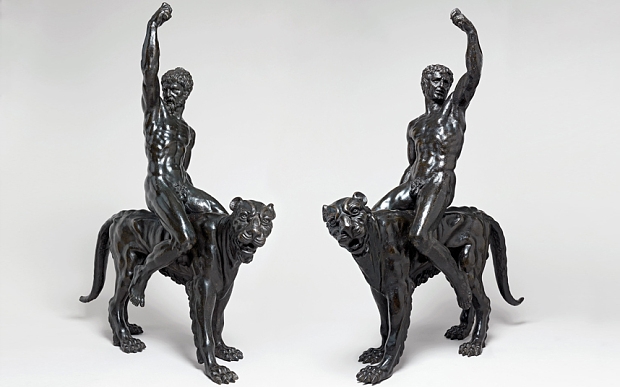A bronze sculpture by Michelangelo is one of the lost Holy Grails of art history. We know he made them, but the most important – an over life-size figure of Pope Julius II – was destroyed by the enraged citizens of Bologna (who had a grudge against the pontiff) a few years after it was made. A bronze David by Michelangelo vanished during the French Revolution. So that, it has always been concluded, was that.
Now the Fitzwilliam Museum has unveiled not one but two bronzes attributed to the great man: athletic naked men mounted on slightly weird feline beasts. It seems too good to be true, but I am more than half persuaded that these are, as the art world says, ‘right’. Put on the spot by John Wilson of BBC Radio 4’s Front Row I estimated my level of conviction at 85 per cent. It tends to rise every time I see the bronzes, because one persuasive point about them is that they – the nudes at any rate – are powerful works of art.
The Fitzwilliam team has marshalled some compelling evidence to support this sensational attribution. Technical examination dates the bronzes to the early 16th century, before about 1530. An analysis of the anatomical accuracy of the two bodies by Professor Peter Abrahams concludes that it is remarkably accurate. The only artists who had a sufficient level of knowledge of anatomy at the beginning of the 16th century, gained from the grisly dissection of cadavers: Michelangelo and Leonardo. And one point is very clear: these aren’t by Leonardo.
On the other hand, a battery of comparisons assembled by the Fitzwilliam team makes it seem entirely feasible that the two bronzes are indeed Michelangelo’s. Especially close matches can be found with drawings for his – long-lost – cartoon of the Battle of Cascina, finished at the beginning of 1505, and various figures from the Sistine Ceiling, begun in 1508. Professor Paul Joannides, who made this bold and brilliant attribution, suggests this period – between 1506 and 1510 – makes the most sense stylistically. One study for the cartoon is close to identical to the back of one of the bronze men.
So, case closed? Well, there are quite a few missing pieces to the puzzle. There is no contemporary reference to these works, indeed no trace of them at all before they popped up in the late 19th century. Neither Vasari, who knew Michelangelo personally, nor Condivi, who wrote an equivalent to an authorised biography during his lifetime, seems to have known about these bronzes.
There is no clue as to the patron they were made for, nor to their meaning. The subject – two naked men sitting on big cats with reptilian tails – is unusual, to say the least. Could they have been part of some larger ensemble? Again, any answer is guesswork. Finally, it is not terribly easy to see an interval of a few months in Michelangelo’s frenetic schedule during which he might have made these things.
None of these objections is fatal. The Manchester Madonna in the National Gallery is a good example of a Michelangelo work unknown before the 19th century, and not mentioned in any early source, which is nonetheless accepted by most scholars (not quite all, but there is a cat-herding aspect to the questions of attribution, particularly when it comes to Michelangelo).
It is, I think, just about possible to find a few months in early 1508 when he just might have had enough time to fit this commission in; and there were one or two people who might have had enough leverage to squeeze a work out of this frenetically busy man, already sought after by the richest and most powerful patrons in Italy though still only in his early 30s.
So I end up in the typical position of one faced with a tricky work to attribute, which could be summarised as ‘yes, but no, but maybe’. When I look at them, though, it’s a good deal more yes than no.
Martin Gayford is the chief art critic of The Spectator and author of a biography of Michelangelo






Comments